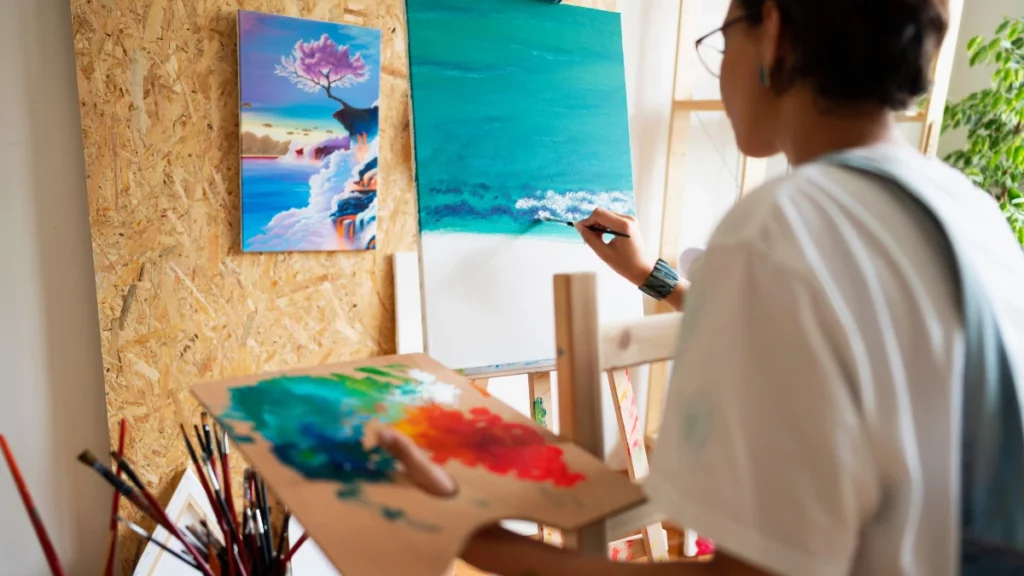For artists who frequently travel, the challenge of managing and safeguarding their art supplies and creations can be significant. Balancing the nomadic lifestyle with the need to maintain a stable and secure space for their artistic materials is a unique dilemma. Self-storage units offer an ideal solution, providing a safe haven for canvases, paints, sculptures, and other art-related items. These facilities offer the flexibility and security that traveling artists require. It enables them to freely explore and find inspiration without the burden of carrying all their supplies with them. Additionally, self-storage units can serve as a personal gallery space where artists can store their completed works. This introduction explores how self-storage units can become an essential asset for artists on the move, ensuring that their valuable creations and materials are protected while they pursue their artistic endeavors traveling around the world.
Identifying Art Supply Storage Needs
For a traveling artist, identifying the specific storage needs for art supplies is crucial. The type of materials, their size, and the frequency of use play a significant role in determining the appropriate storage solution. Artists working with large canvases or sculptures require spacious units, while those with smaller, more delicate materials like brushes or paints need less space but more organizational features. The climate sensitivity of certain materials, like oil paints or clay, also influences the choice of storage. It’s because these items need stable temperature conditions to preserve their quality.
Accessibility is another key factor; traveling artists often need to retrieve or store items at irregular hours, making 24 hour self storage units an attractive option. These units provide the flexibility to access supplies anytime, which is essential for artists. Their inspiration or work schedule doesn’t conform to the typical nine-to-five.

Choosing the Right Storage Facility
Selecting the ideal storage facility is a critical decision for traveling artists. It also affects the safety and accessibility of their precious art supplies.
When evaluating storage options, several factors must be considered to ensure the facility meets specific artistic needs:
- Location Proximity: Choose a facility close to your frequent travel routes or art venues.
- Security Measures: Look for facilities with robust security, like surveillance cameras.
- Access Hours: Ensure the facility offers access hours that suit your schedule.
- Climate Control: Opt for climate-controlled units for temperature-sensitive materials.
- Size Options: Select a unit size that accommodates your collection without crowding.
These criteria help artists find a storage solution that provides peace of mind and convenience. The Smithsonian American Art Museum, a resourceful hub for artists, emphasizes the importance of proper care and storage of art materials.
Organizing Art Supplies in Storage
Effective organization within a storage unit is vital for traveling artists to maintain and access their supplies efficiently. A well-organized space can significantly enhance the ease with which artists retrieve and store their materials, contributing to a smoother creative process. The first step is categorizing supplies based on type and frequency of use. This system allows for quick identification and minimizes the time spent searching for specific items.
Utilizing shelving units and storage bins is a practical approach to maximize space and keep supplies in order. These should be clearly labeled, perhaps by medium, project, or color, depending on the artist’s preference. It’s also beneficial to allocate a designated area for finished artworks, ensuring they are stored safely and separately from materials and tools.
Climate Control for Art Preservation
For traveling artists, preserving the integrity of their art supplies and finished works is paramount, making climate control in storage units an essential consideration. Certain art materials are also highly sensitive to temperature changes and humidity, which can cause irreversible damage.

Key aspects to consider for climate-controlled storage include:
- Temperature Stability: Maintaining a constant, moderate temperature prevents warping and cracking in materials like wood and canvas.
- Humidity Control: Proper humidity levels protect against mold growth and paper degradation.
- Protection from External Elements: Climate control ensures that artworks are safe from external environmental factors like rain or snow.
The Getty Conservation Institute provides further insights into the preservation of art materials, emphasizing the importance of environmental control. By choosing
a storage facility that offers climate-controlled units, artists ensure the longevity of their supplies and artworks. This is especially crucial for materials like oil paints. It can react to extreme temperatures and paper-based works that are susceptible to moisture.
Security Measures for Art Storage
When it comes to storing art, security is as crucial as the creative process itself. For traveling artists, ensuring their artwork and supplies are safe during their absences is a top priority. Modern self-storage facilities are equipped with advanced security measures like 24/7 surveillance cameras, secure gated access, and individual alarms for each unit.
These features provide artists with the confidence that their works are protected against theft or vandalism, much like how travel insurance offers peace of mind during their journeys. In addition to external security, many storage units also include internal safeguards such as fire-resistant materials and flood protection, further securing the artwork from potential disasters. This comprehensive approach to security allows artists to focus on their travels and creative explorations, knowing that their valuable and irreplaceable art materials are well-protected.
Unleashing Creative Freedom
In wrapping up, it’s clear that self-storage units offer traveling artists a blend of flexibility, security, and preservation for their art supplies and creations. These facilities not only provide a practical solution for storage needs but also contribute significantly to the artists’ peace of mind, enabling them to pursue their creative passions without boundaries.

